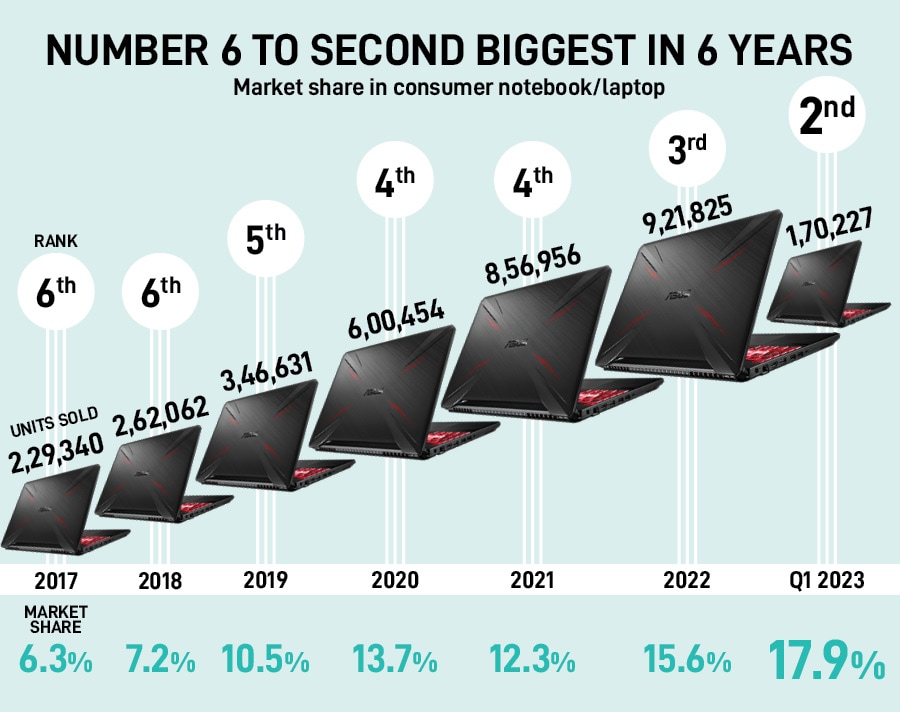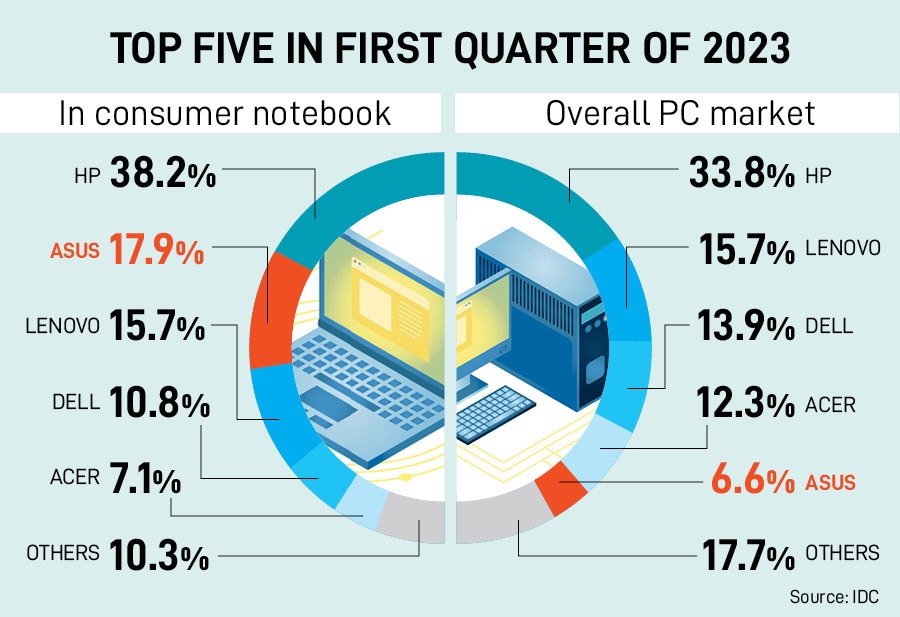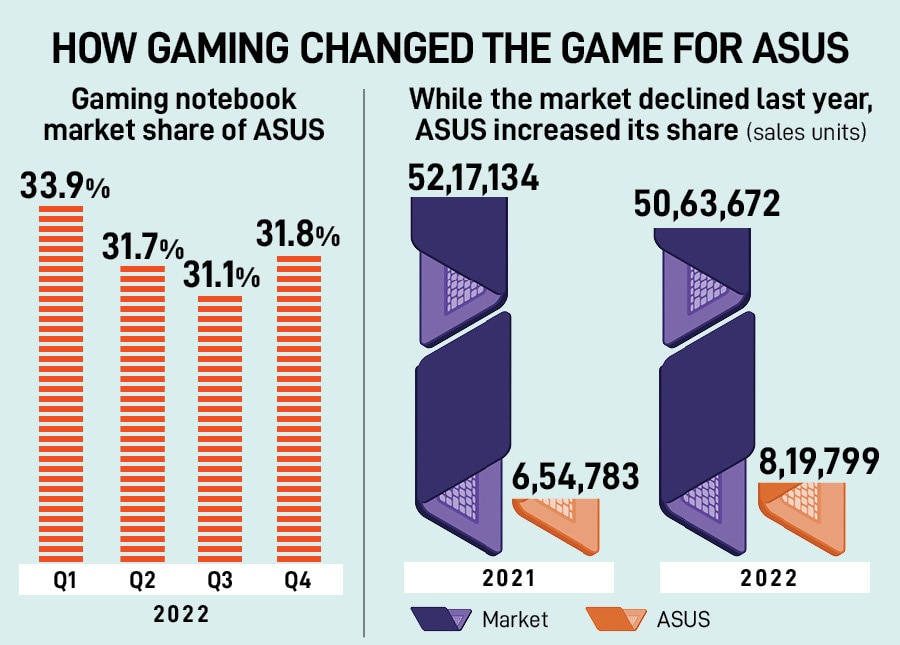Ahead of the game: ASUS hits a high note in India
A Taiwanese major has become second biggest consumer notebook brand in a market that has been sliding over the last few quarters. Can ASUS topple HP to become biggest in India?


Arnold Su starts the conversation by baring his ambitions. “Our goal is to reach the number one position in India," underlines the vice-president (consumer and gaming PC), system business group of ASUS India. The Taiwanese biggie entered India by rolling out motherboards and graphic cards in 2000. Six years later, in 2006, it launched ‘Republic of Gamers’ (ROG) brand for gaming, introduced first gaming laptop in 2007, and after twelve months started focusing on the notebook business in the country. “India has been a tough market," says Su, who came to India in 2012. Back then, there were over a dozen laptop brands, and ASUS languished at the lower tier of the pecking order. Over a decade later, in the first quarter of this year, ASUS became the second biggest by grabbing a 17.90 percent market share in the consumer laptop segment, and zoomed ahead of rivals Lenovo, Dell and Acer. “Now, we want to become biggest," Su reiterates.
The trek to the second slot has not been easy. Su explains the early challenges. For any foreign brand, if the size of the country comes as an eye-popping opportunity, the sheer diversity turns out to be intimidating. “When we entered such a big market, the most difficult part was to realise that it’s not just a single country," says Su. “It"s a kind of countries within a country," he exclaims. Every state has different culture, requirements, consumers, and taste. “So, the strategy to cater to such a heterogeneous market was a big challenge," he recalls.
One big learning was one size doesn’t fit all. “We realised that not every state will require same product," says Su. Take, for instance, screen size. Users in the Northeast require 14 inch screen but the rest of India needs 15.6 inch. One can’t design a general marketing strategy for the country. Any plan must have layers and marketing and advertising nuances. “You need to have a customised plan for different states," he says.

A sharp focus on technology helped them in establishing foothold. “What differentiates us from our competitors is that we are not here to sell me-too products," Su adds. “We are here to sell technology," He underlines by dishing out examples of how the brand stayed ahead of the curve. In 2007, ASUS launched the first mini laptop, a 10 inch screen, in India. In 2011, it was the first brand to launch ZenBook, a thin, lightweight and high-end laptop. “In 2013, we launched the detachable laptop, and in 2019 we rolled out dual-screen laptop," says Su, adding that back in 2006, ASUS was the first brand to launch gaming laptops in the world.
Being ahead of the time in rolling out heavy tech-loaded product was not easy. In 2006-07, the gaming laptop market in India was almost non-existent. For the users in the hyper-niche segment, there as only one way to get a gaming laptop: DIY (do it yourself). The task was arduous, and one had to assemble everything: from motherboard to graphics card. ASUS wanted to be ahead of the curve, even if that meant having miniscule sales.
Also listen: Why Indians aren"t buying laptops anymore and should you buy one today
There was also another big early learning which changed the dynamics for ASUS in India. For decades, most brands has looked upon India as an entry-level market, which means a country which doesn’t have appetite to buy premium products. ASUS shunned the herd mentality. Take, for instance, Zephyrus G14. In 2020, ASUS rolled out the brand at a price tag of Rs80,000. Critics and rivals were quick to take a dig at the brand, underlining that the price was prohibitive.

The reality turned out to be surprisingly different. “This machine (Zephyrus G14) has sold more units in India than the US, China and Europe," claims Su. In 2021, he dishes out another example, Zenbook Duo was rolled out and had a price range between Rs85,000 and Rs2 lakh. “It has sold very well in India," he says. ASUS, Su adds, never banked heavily on entry-level products, which is available between Rs50,000 and Rs60,000. Entry-level is 45 percent of the Indian market. “The remaining 55 percent gaming laptop market is Rs80,000 to Rs4 lakh," he says. “If we do so, then there is no difference between ASUS and our competitors," he says.
The gambit to focus on the premium range of laptops—both consumer and gaming—is paying off. At a time when Indian PC market has seen three consecutive quarters of decline since the third quarter of 2022, ASUS has been steadily improving its market share.

The secret sauce had two interesting ingredients: Focus on premium segment, and dominating the gaming laptop market. While the gaming laptop market declined from 52 lakh in 2021 to 50 lakh in 2022 (see box), ASUS sold more—6.5 lakh to 8.19 lakh—during the same period. “Asus dominate the entire premium segment from Rs80,000 to Rs2 lakh of gaming laptop. We have more than 40 percent market share," claims Su. Now, contrast this with the market share in the entry-level segment. “It’s around 20-25 percent," he adds. In the first five months of this year, Su underlines, while consumer laptop market declined by around 12-13 percent, ASUS’ gaming laptop market increased by 10 percent. “Consumer notebook is falling and this market is growing," he adds.
Marketing experts point out another factor that has helped the brand from Taiwan. “A continued focus on offline channels over the last four years has helped in expanding share," reckons Ashita Aggarwal, professor of marketing at SP Jain Institute of Management and Research. While most brands erred in their judgement regarding the power of offline due to the pandemic, ASUS kept on expanding its brick and mortar reach. Before the pandemic, it had only 60-70 exclusive stores. In 2023, the numbers have crossed 220-mark. “They planned for the future," she adds. The challenge, though, is to improve its overall ranking in the PC market, where it is still placed at fifth position. “Biggest in one big segment versus biggest overall is a call which they have to take," she adds.

Su is also looking and planning for a promising future. “We are hungry for business," he says, underlining that the brand must always stay humble. “No matter what our ranking is, we still have lots to learn," he says. The biggest learning, he points out, is to have a strategy which is at least three years ahead of the time. “We are confident that we will become the biggest," he says.
First Published: Jun 26, 2023, 15:39
Subscribe Now